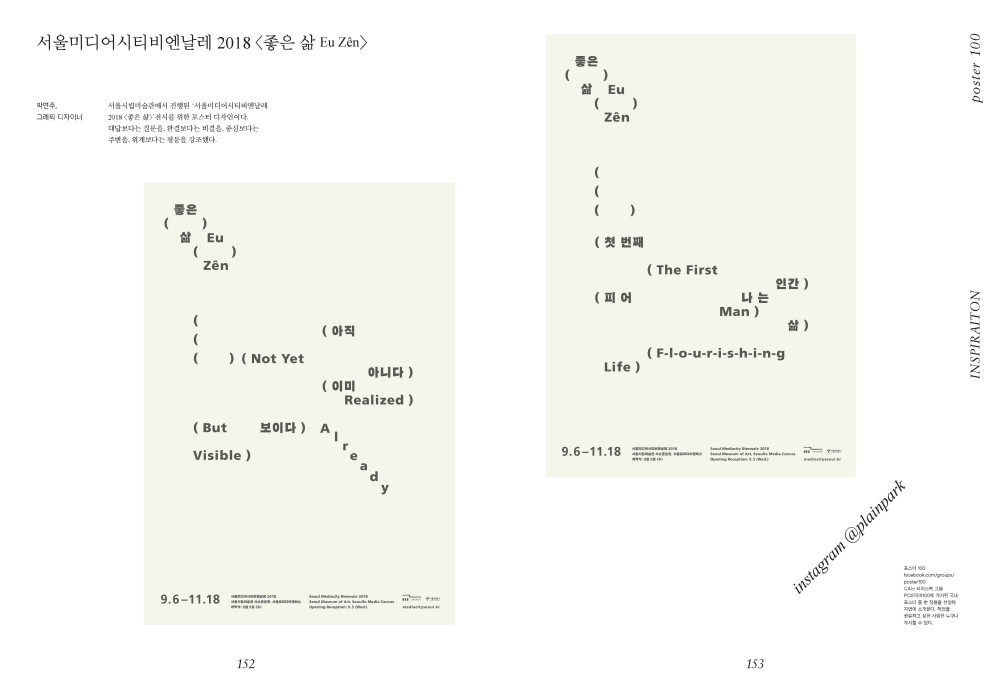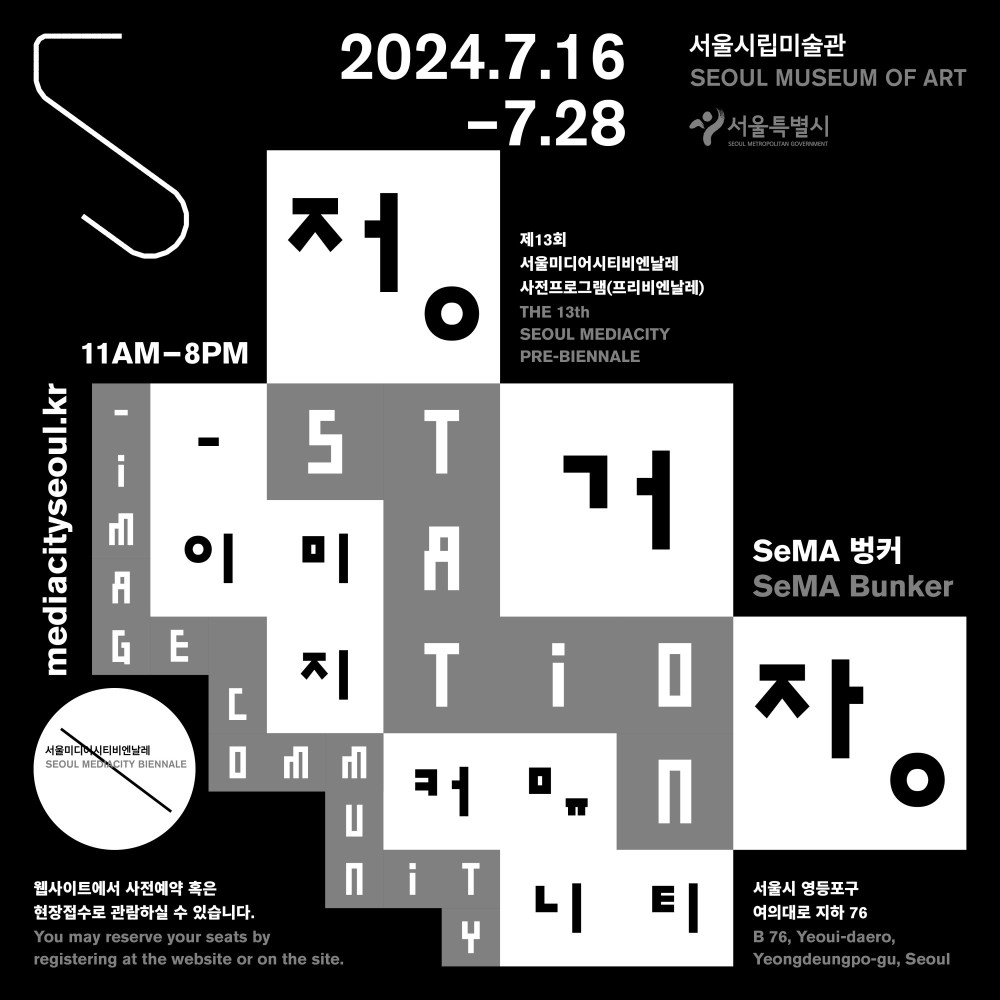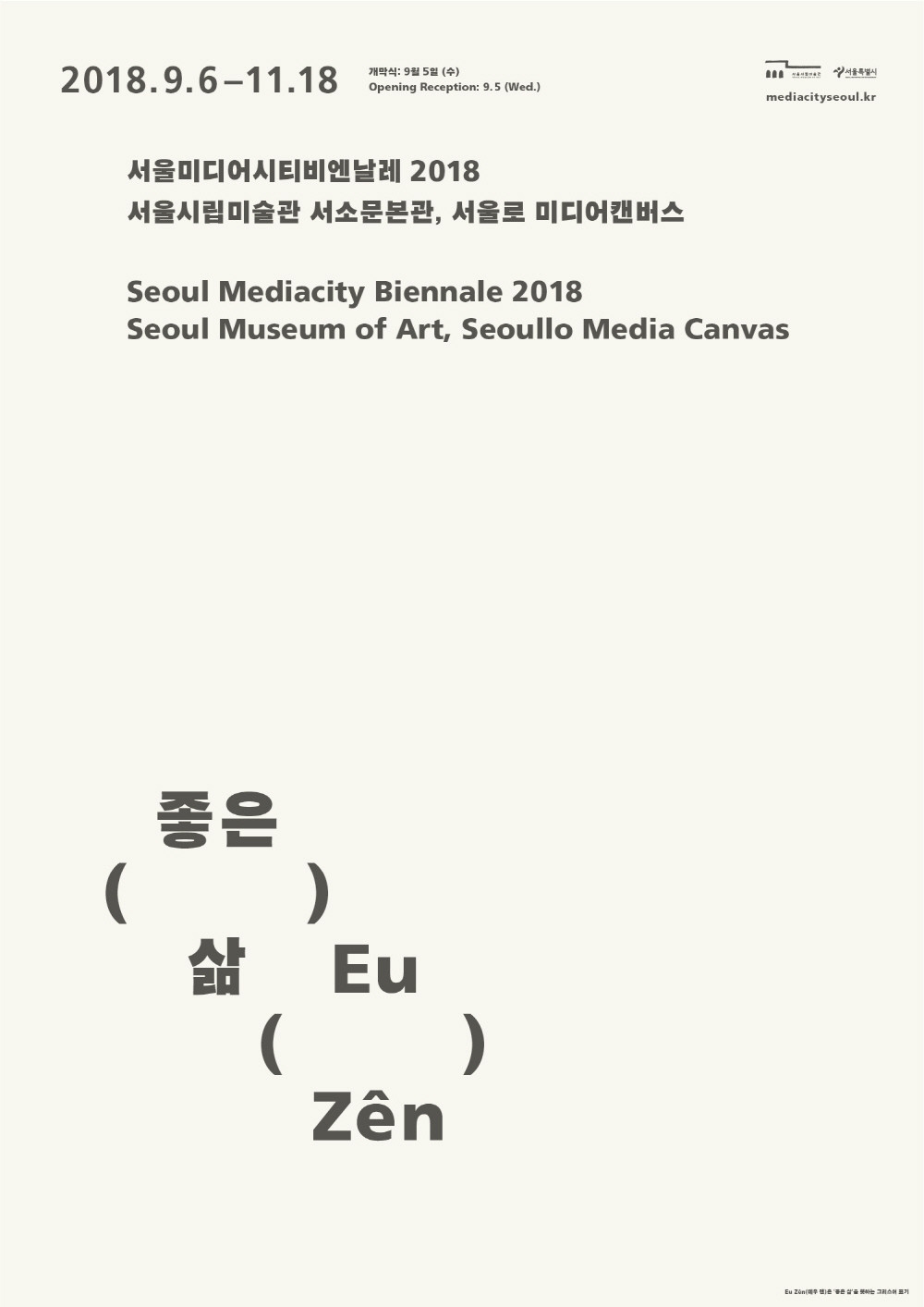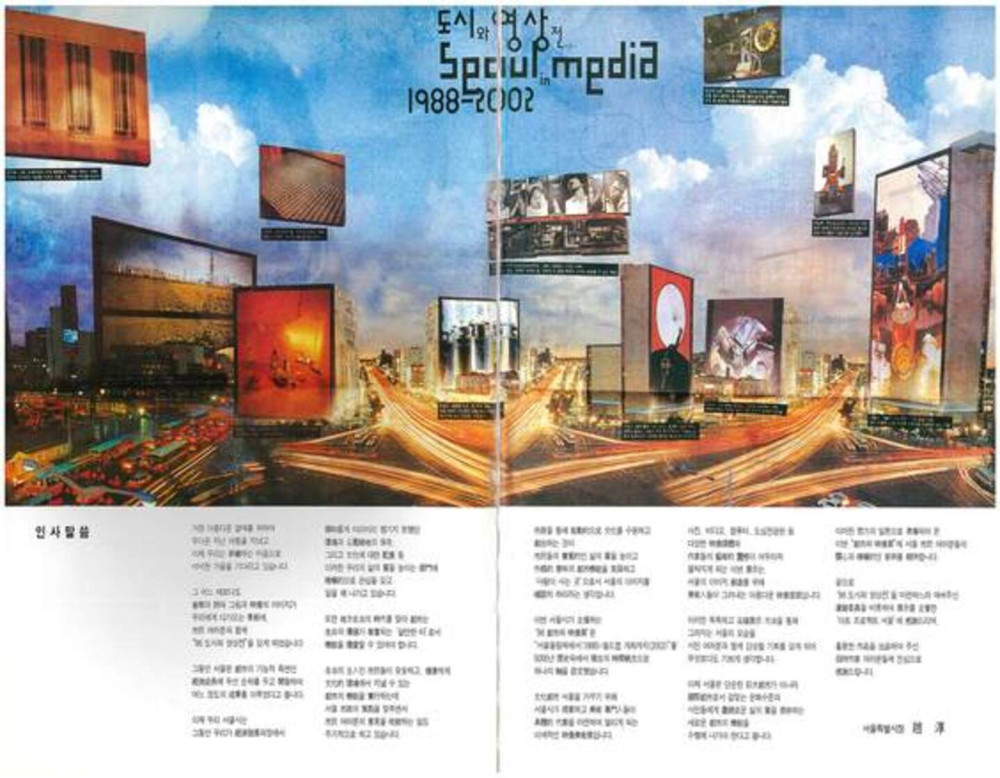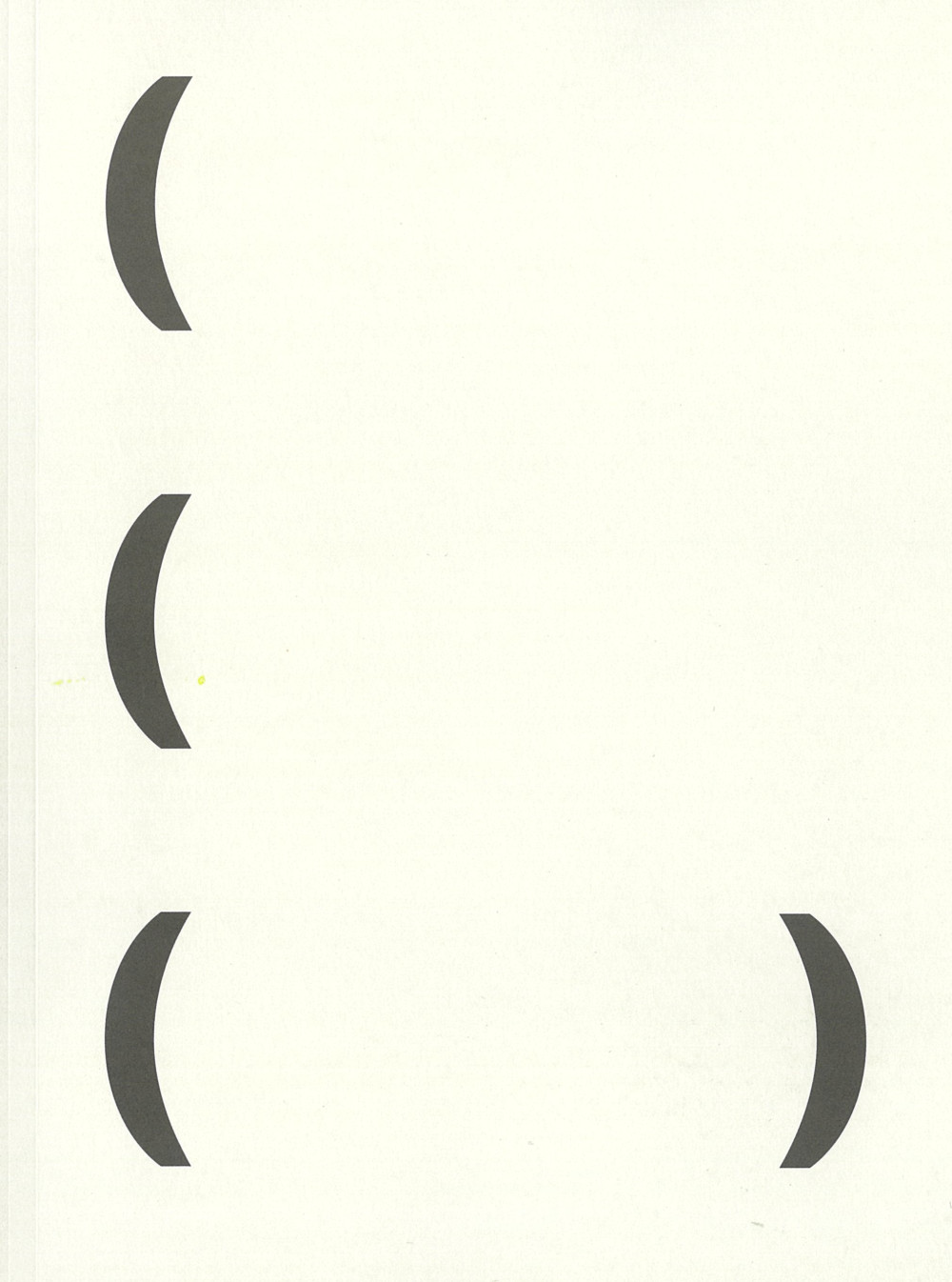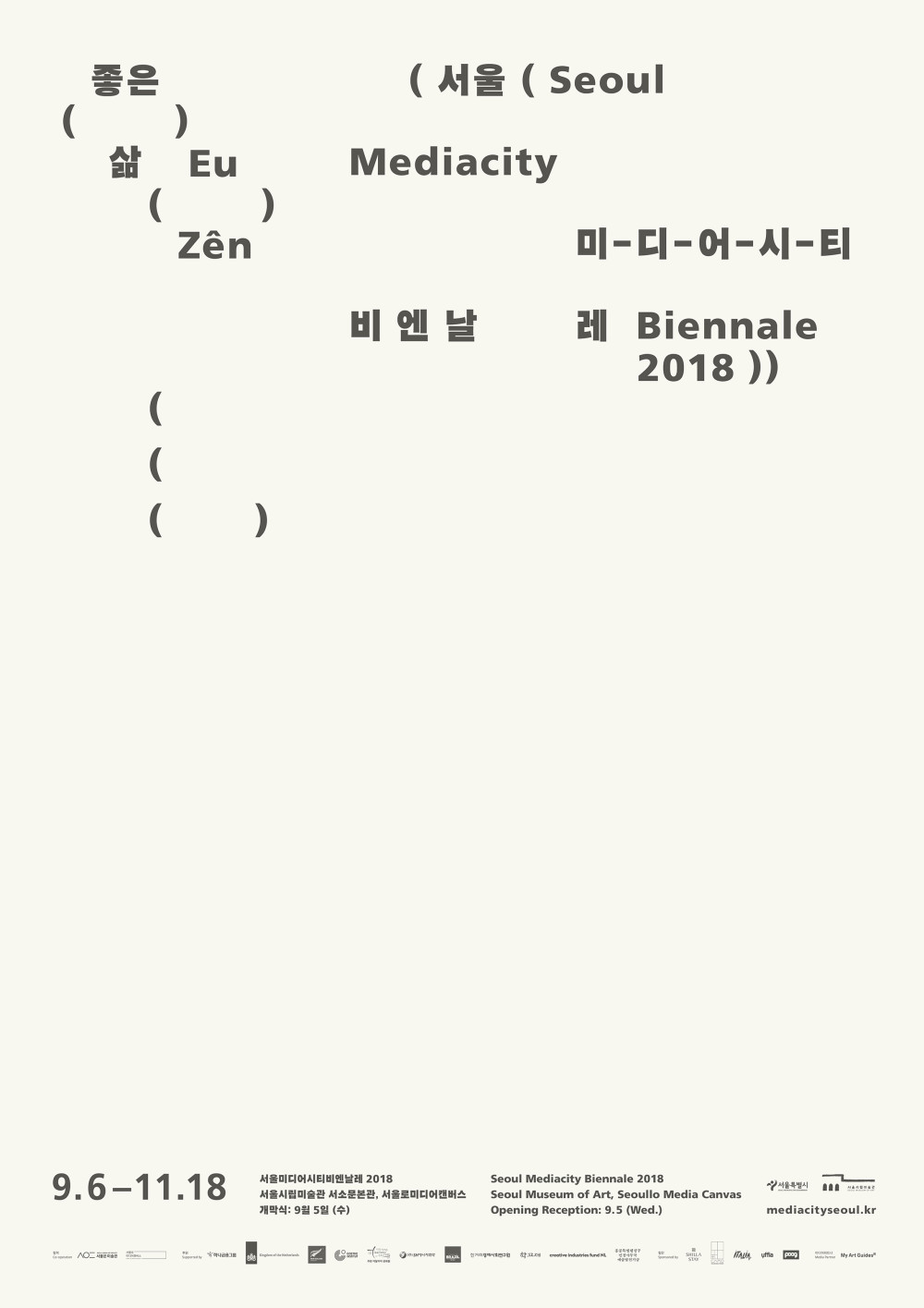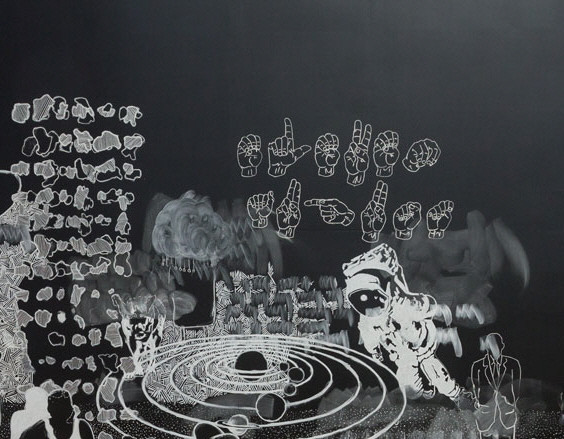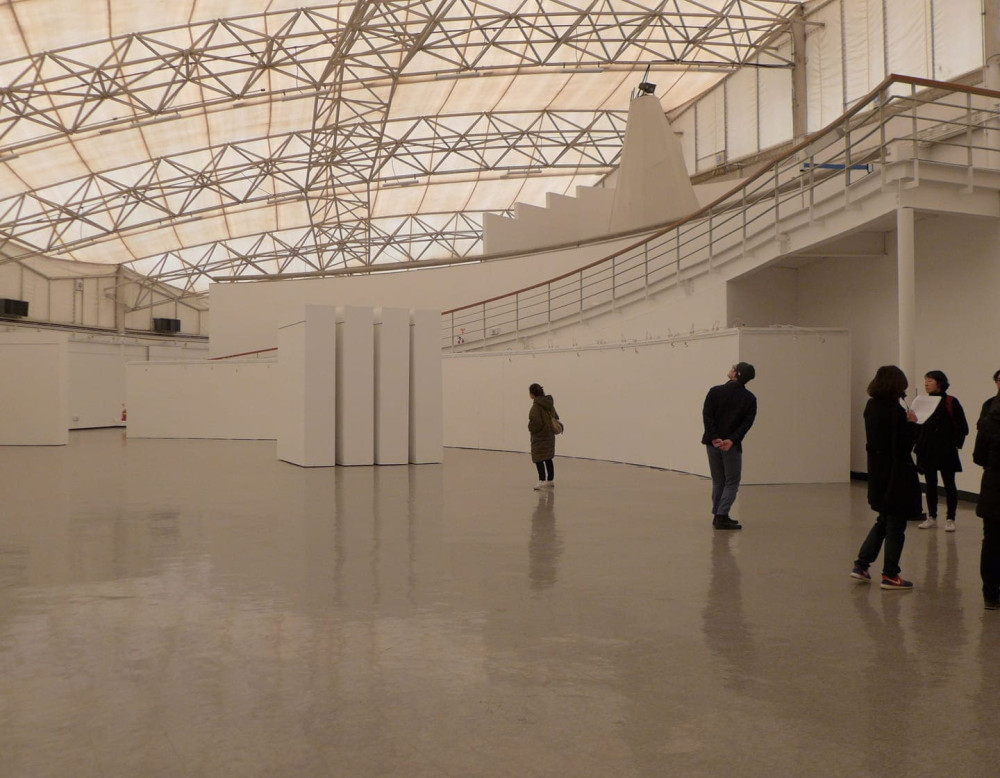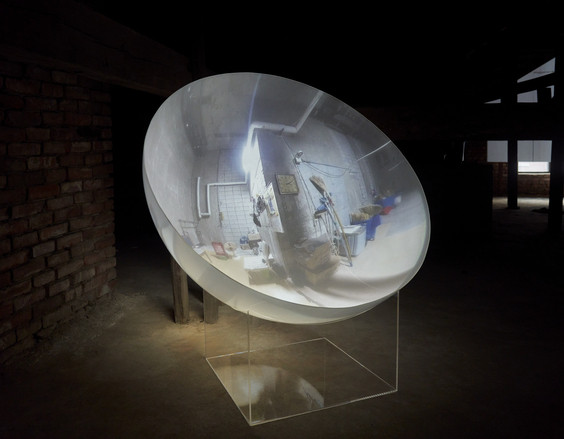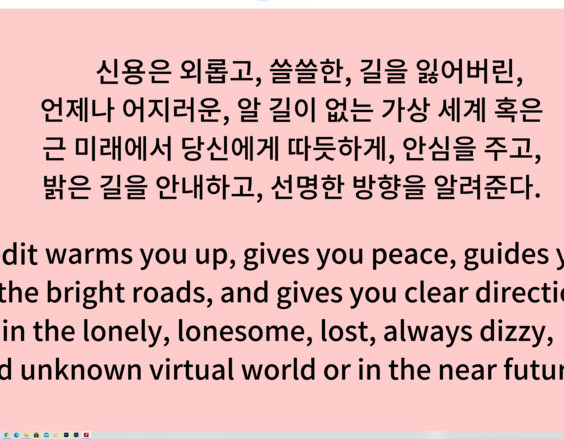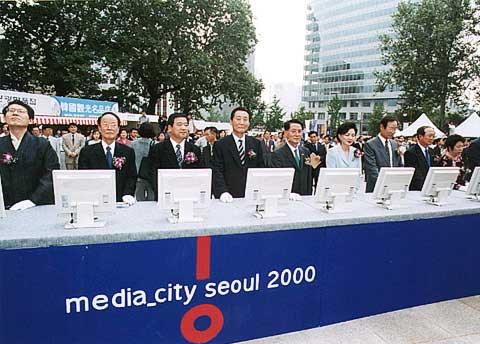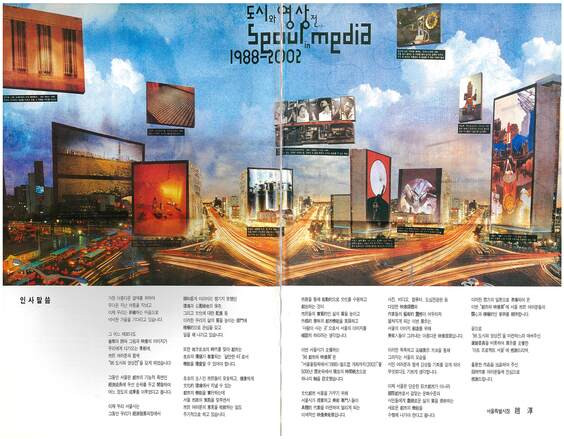(Biennale and Design)

This interview is a conversation with Park Yeounjoo, graphic designer for the 10th Seoul Mediacity Biennale, about the process and sustainability of biennale design. It includes an edited transcript of the voice recording, related image materials, and the interviewee’s biography.
Park Yeounjoo is a designer who focuses on language, typography, books and the common structures, arrangements and sequences shared by these elements. She is also involved in publishing through Hezuk Press and lecturing at various universities.
Research Title (Biennale and Design)
Category Interview
Edition The 13th Seoul Mediacity pre-Biennale
Participants Park Yeounjoo, Seoul Mediacity Biennale Office
Korean-English Translator Barun
English Copyediting Andy St. Louis
The 13th Seoul Mediacity pre-Biennale (2024), in keeping with the objectives of the previous pre-Biennale (2022), continues to explore conceptual media, evaluate the identity of Seoul Mediacity Biennale (SMB), encourage local engagement and expand the project’s purview based on accumulated resources from throughout its history. This series of interviews focuses on the development of the Biennale over the past decade by recording the experiences of experts who have created new roles in Korea’s evolving contemporary art scene.
In 2018, SMB10 Eu Zên, was the first edition of the Biennale to be organized not by a single artistic director, but by a directorial collective comprised of various practitioners from outside the field of art. Their goal was to move beyond the scope of contemporary art and address a wide range of subjects through the Biennale, including art, economy, environment, politics, society and technology, while creating an open exhibition that actively communicated with its participating artists and general audience. The Biennale’s design translates various concepts and ideas into visual outcomes and has always served as a crucial medium that reflects the characteristics of each edition of SMB. This interview with designer Park Yeounjoo discusses how SMB10 Eu Zên was realized.
SMB Before we discuss the SMB10, can you briefly outline your previous experiences that led to serving as a designer for the Biennale?
Park Yeounjoo (PARK) After graduating with a degree in visual design in 1995, I immediately started working at a design studio, where I worked as a designer for about eight years. To be honest, after five to six years into the job, I started to feel disillusioned with my work. The struggle of negotiating with clients over design drafts had begun to outweigh the joy I once derived from the process. I also began to question whether I was merely creating garbage when I looked at the finished products. Around the same time, I became deeply engrossed in books on Neo-Luddism, anti-capitalism and the “First Things First” manifesto. I even seriously considered moving to the countryside to pursue a life of self-reliance, but I realized that I was too young and had too many desires to take that step. I endured for another two to three years, then decided to quit when I felt I had reached my limit. In 2004, I entered graduate school and after finishing my masters’ studies I opened my own studio in 2007. That was when I became an independent designer.
SMB Since 2009, you’ve been running the independent publishing house Hezuk Press and in 2023 you served as artistic director for Typojanchi, an international typography biennale held in Seoul. Can you elaborate on your endeavors to expand the scope of a designer’s activities?
PARK After opening my studio in 2007, I started receiving occasional commissions to design exhibition catalogues and artists’ books. I discovered that some of these publications were being produced without ISBNs. I wanted to create official records from some of these print materials, so in 2009 I registered a publishing house under the name Hezuk Press and released its first publication in 2012. Around 2013, I suggested to the artist Chung Heeseung that we should plan a publication together. This led to the release of the first issue of the Float series in 2014. Since then, Chung and I have continued to develop Hezuk Press together.

For Typojanchi 2023, I was appointed artistic director by the organizing committee. Thinking back on that experience, I now realize that the principles of designing, publishing and creating exhibitions are not vastly different. I always approach typography and book-making with a focus on establishing structures, which is essentially about defining relationships between components; the similarity to curating lies in bringing different components together and determining how to relate them to one another. Expanding my activities as a designer was not about augmenting the scope per se, but rather about seizing opportunities that came my way and avoiding stagnation.
SMB For SMB10, a collaborative group of artistic directors was selected, including a dance critic, art curator, publisher and economic researcher. Being charged with developing a unified design language out of diverse opinions and directions must have been challenging for you as a designer. How did you become involved in this edition of the Biennale?
PARK While running my studio, I naturally work on a lot of contemporary art design through my connections with artists and acquaintances in the art industry. I submitted my portfolio upon the request of the directorial collective and subsequently received an invitation to participate. SMB10 was my first encounter with biennale design and it was a sizable undertaking for me. I believe it’s crucial to decide who will make the final design decisions for a project, and I anticipated that setting a clear direction would be challenging within such a collaborative artistic director system.
SMB What were the various tasks and processes assigned to you as a designer for SMB10, from scheduling to production? Can you discuss some of the specific steps such as regular design meetings that were involved in achieving the final output?
PARK The deliverables assigned to me included establishing the visual identity for the Biennale as well as designing communication materials such as posters, online and offline banners, ads, trailers, exhibition graphics, the official website and catalogue. In short, I was responsible for creating almost all the visual materials related to SMB10. The production process was similar to that of other design projects and involved creating design drafts, proposing them in design meetings and then adjusting and revising them until the design was finalized. However, as I already mentioned, the collaborative artistic director system made the process of gathering opinions particularly challenging. During the initial design meetings, each member of the directorial collective seemed to have different ideas about the Biennale’s theme, which made it difficult for me to fully grasp the essence of SMB10. The exhibition itself was challenging to understand; despite reading the overview and receiving explanations, it still seemed vague to me. When preparing the poster design, I asked the directorial collective to identify a set of key terms, which I then used as context when conceptualizing the Biennale and ultimately as the foundation of my graphic design.
SMB Many people consider the content presented at biennales to be complex or specialized. As such, biennale curators and designers must generate public appeal while also creating a unique identity. In this light, your decision to focus on unembellished typography for the SMB10 design seems quite bold. Could you explain the methodology behind this graphic identity?
PARK I started by inserting parentheses between the words “Eu” (good) and “Zên” (life), suggesting that while an exact meaning might be unclear, we should explore it together. In this way, I sought to encapsulate “the realm of possibilities.” Nevertheless, this initial proposal was somewhat different from the final design; I wanted to break away from a conventional biennale identity through the use of a more casual typeface like handwriting, but the idea was not well received by the directorial collective. One member was against using parentheses and since there was a general lack of open and honest discussion, individual positions were not fully transparent. This meant that whenever someone strongly voiced their opinion during a polite meeting, it was difficult for others to decisively state their opposition. In terms of the graphic identity, I wanted to avoid making it a “spectacle” and instead preserve the feeling of small elements that were somehow dispersed and connected. One of the core concepts for SMB10 was “agora” (square), which also expanded to the scenography of the exhibition and manifested as a dandelion-like form in which scattered individual elements would radiate from a central space. I wanted to use a more substantial font while maintaining a decentered composition, so I proposed a new poster image featuring intersecting keywords using Korean and English alphabets with empty parentheses. In the design magazine CA, I have previously written that the identity of SMB10 emphasized “questions over answers, methods over results, periphery over center, and equality over hierarchy.” Ultimately, I was able to realize my intended direction of the final design, partially due to the tight production schedule as well as gaps in decision-making by the directorial collective. The design ended up taking on an ambiguous form that was not fully satisfactory to everyone, yet no one was strongly opposed to it either. Looking back, it seems like a design that might not be easily accepted as a typical biennale identity.
SMB The design of the Eu Zên catalogue reflects your typographic experimentation. Its layout mixes Korean and English typefaces and its arrangement of contents is unconventional. How was this possible and what were the motivations for these design choices?
PARK The Eu Zên catalogue took a somewhat unique approach. Instead of focusing on the final results of the Biennale, the plan was to feature specific aspects of the artists’ working processes. Since each artist provided different kinds of texts and visual materials, we decided to orient the design according to the different characteristics of these diverse contributions rather than imposing a uniform approach. I enjoy working in the space between conveying information and creating disruptions or fissures through editing and typography, so it was an interesting project for me. Usually in design work, content is viewed as fixed information. If a designer were to completely deconstruct this fixed information, that might be attributed to an inability to fulfill their responsibilities. Notwithstanding, it is possible to delay the delivery of information or introduce some confusion, and what I’m interested in is creating structures wherein information is delayed through the arrangement of characters so that the same information can be read differently. I also have a strong interest in bilingual and multilingual typesetting so I experimented with various methods of incorporating both Korean and English in the Eu Zên catalogue.

SMB Some people argue that the advantage of biennale catalogues is their unpredictability, since there is no predetermined structure for such projects. How would you describe the differences between biennale publications and other types of publications?
PARK Biennales can provide opportunities for various experimental publications, which correspond to their particular elements and objectives. However, what I find problematic in the Korean art world at large, not just in biennales, is the lack of recognition of professional editors. Some authors in the art world consider the editing process as somehow damaging or interfering with their text. When vague and verbose manuscripts are accepted as final drafts, it diminishes the designer’s motivation to create a good book. I was relieved that Yumi Kang was invited as an editor for SMB10. Despite the tight deadline, she was able to compile and organize a vast amount of material and hand it over to me within a short timeframe.
SMB Biennales require designers to develop a condensed visual language that effectively conveys content, as well as considering communication methods via various platforms and create visual variations accordingly. In Korea, the scope of a designer’s duties often also includes overseeing production, which can be quite extensive. Since the period for organizing SMB is condensed into a short timeframe, some people suggest dividing the design team into smaller groups. How did you address such concerns during SMB10?
PARK Given the extensive amount of work to be done and the limited amount of time, it was challenging to handle everything alone. In our case, designer Youjeong Lee assisted with design variations and video trailer production. Dividing the design work among several teams at the museum is something that would have its own benefits and drawbacks: although the work might not proceed smoothly due to the need for different teams to coordinate within such a short production phase, it could also provide opportunities to collaborate with new people. Personally, I believe that increasing the budget for a single design team and allowing them to collaborate with various project teams could help clarify goals and responsibilities, ultimately contributing to the creation of a successful identity. However, I’m not sure if the administrative situation of Seoul Museum of Art (SeMA), the hosting institution, can accommodate such a structure.
SMB Moon Jung Jang, a designer who participated in the publishing program of the SMB09 (2016), mentioned that biennale designers often find themselves in situations where they must ask many questions about the role they should play. She said that it’s necessary to have flexible knowledge and a learning attitude in order to foster effective collaboration, rather than merely focusing on the outcome of the design. How would you define your own philosophy or attitude as a designer? Have you experienced any notable instances of compromise or adjustment between the ideals, realities, objectivity or neutrality of design during your various activities?
PARK Before discussing my philosophy as a designer, I would like to assert that as an individual, I am constantly aware that many concepts, definitions and distinctions in the world are created for human convenience. Therefore, the world seems like a shifting pointillist artwork to me. I often struggle with certainty and tend to postpone making judgments. To answer your question, I don’t think I have a particular design ideal. Instead, I aim to clearly understand the type of person and designer that I am. I also try to be as courageous as possible with the design I am capable of creating. Regarding communication, I believe that finding suitable collaborators is just as important as improving verbal dialogue. As long as designers including myself reveal their uniqueness and those who commission or collaborate on design understand each designer’s individuality, difficulties arising from communication can be significantly reduced.
SMB Despite the evaluation that SMB10’s directorial collective was a unique attempt, there has also been criticism of its lack of gender diversity. You have participated in gender-focused gatherings and exhibitions like the Feminist Designer Social Club (FDSC) and The W Show (SeMA, 2018), as well as successfully establishing your position as a prominent female designer among your generation. How has gender equity in the design field improved since your early days and what has been your experience since the beginning of your career?
PARK When I first started working at a design studio, there were almost no female designers in leadership positions at the company, let alone at major design events or organizations. Although some female designers had begun their careers before me, they were vastly outnumbered by men. Today, it seems that there are many more women working as designers and studying design at university. However, middle-aged men still predominate in positions of power and decision-making, and their activities also receive more of the spotlight. I believe that the achievements and contributions of female designers need to be deeply addressed and evaluated.
For young female designers running their own studios, I hear that they are still frequently greeted by clients with expressions of disbelief such as “Are you really the lead designer?.” This reflects an underlying widespread perception that young female designers are not reliable. I also had similar experiences when I was younger. It’s hard to be completely immune to sexism when you grow up in Korea’s patriarchal society, and I am no exception. However, what matters is your attitude when recognizing problems. If you have an awareness of the issues and a desire to implement changes, it becomes possible to engage in open dialogue.
SMB Currently, one of the major tasks of SMB is creating an integrated website. Considerations for UX and UI design to address new media environments and mobile devices, as well as assembling a design team composed of experts in programming and development languages, are crucial directives of this initiative. To what extent did you work with collaborators on the website for SMB10?
PARK The directorial collective separated the tasks of website development and design, and since I couldn’t handle the web development myself I turned to artist Jinhwon Hong to oversee the programming aspect. We discussed how much of my design vision could be realized and I was really impressed by how quickly he produced the official SMB10 website. I believe an integrated website will be important for resource management and sharing information about the Biennale, but it should also reflect the excitement of encountering a new visual language or online environment with each edition of SMB. Since the title of SMB includes “media” in its name, I am interested to see whether the website will be actively utilized in terms of creating new connections with various media and doing experiments based on its digital parameters. For SMB10, we embedded live-streamed event videos on the website’s homepage, which I thought was a successful attempt.
These days, with the rise of social media and online promotions and the decline of conventional print media , I sometimes find it burdensome to preserve printed materials. The shift to digital media seems natural and I expect it to accelerate in the future, but since I am not very familiar with non-printed formats I always need help with digital tasks and I value the process of collaboration. In this way, I try to understand the characteristics of my collaborators by talking with them directly and making concerted efforts to express my gratitude for their collaboration, even though I may be clumsy at doing so.
SMB In an era with countless cultural and artistic contents, what are your thoughts on the necessity and sustainability of biennales? Typojanchi is the only Korean biennale focused on typography and design, and it has continued for over 20 years. Just like SMB, Typojanchi operates by a public fund, so it must serve the public interest while also making meaningful contributions to various cultural and artistic activities. The budget reductions that now threaten Typojanchi’s future prospects highlight the importance of diversity in the biennale ecosystem as well as the need for stable systems and operations, all of which are urgent issues for SMB.
PARK Typojanchi is certainly in a precarious situation. The budget has been continuously cut and even when I was serving as the artistic director, there were rumors that its forthcoming edition would be canceled. Events like Typojanchi, which have a unique identity and have been sustained through the efforts of many designers, could disappear in an instant. That would be truly unfortunate. It is my hope that significant biennales could continue indefinitely, but it’s hard to expect qualitative and professional approaches from government and local authorities who mostly make decisions based on quantitative evaluations. In the case of Typojanchi, forming a new organizing committee and seeking ways to sustain the biennale independently are currently underway. Likewise, creating a dedicated SMB team within SeMA as well as running pre-programs and archiving previous events would certainly be valuable for the long-term stability of SMB.
Interview Date: June 24, 2024
